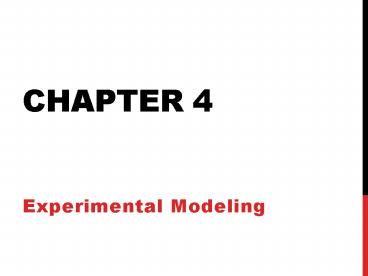Experimental Modeling - PowerPoint PPT Presentation
1 / 12
Title:
Experimental Modeling
Description:
Cubic Spline Models. The construction of cubic splines for more data points proceeds in the same manner. That is, each spline is forced to pass through the endpoints ... – PowerPoint PPT presentation
Number of Views:65
Avg rating:3.0/5.0
Title: Experimental Modeling
1
Chapter 4
- Experimental Modeling
2
Introduction
- Recall the difference between curve fitting and
interpolation. - In many cases the modeler is unable to construct
a tractable model form that satisfactorily
explains the behavior. - The modeler may conduct experiments (or otherwise
gather data) to investigate the behavior of the
dependent variable(s) for selected values of the
independent variable(s) within some range. - With this information, the modeler can construct
an empirical model based on the collected data
rather than select a model based on certain
assumptions.
3
4.1 Harvesting in the Chesapeake Bay and Other
One-Term Models
- Consider a situation in which a modeler has
collected some data but is unable to construct an
explicative model. - Harvesting of bluefish and blue crabs versus time
(the model may help to predict availability).
4
Harvesting in the Chesapeake Bay and Other
One-Term Models
- Use the Ladder of Transformations to linearize
the data
5
4.2 High-Order Polynomial Models
- Polynomial Models
- You need a polynomial of degree at most n to fit
the polynomial uniquely (and exactly) through a
data set with n points. Why?
6
High-Order Polynomial Models
- Advantages and Disadvantages of High-Order
Polynomials - Advantages
- Easy to integrate and to differentiate
- Disadvantages
- Rational functions are far more appropriate to
approximate data sets having a vertical
asymptote. - High order polynomials tend to oscillate severely
near the endpoints of the interval of the data
set. - Very sensitive to small changes in the data
7
4.4 Cubic Spline Models
- Cubic Spline Interpolation
- By using different cubic polynomials between
successive pairs of data points, we can capture
the trend of the data regardless of the nature of
the underlying relationship, while simultaneously
reducing the tendency toward oscillation and the
sensitivity to changes in the data. - Linear Spline
8
Cubic Spline Models
- Consider now a model that has continuous first
and second derivatives - Define a separate spline functions for the
intervals x1, x2) and x2, x3
9
Cubic Spline Models
- Requirements
- Each spline should pass through the two data
points speci?ed by the interval over which the
spline is de?ned. - Smoothness
- Adjacent first and second derivatives must match
at the interior data point (in this case, when x
x2)
10
Cubic Spline Models
- Requirements
- We still require to additional independent
equations. Although conditions on the derivatives
at interior data points have been applied,
nothing has been said about the derivatives at
the exterior endpoints. - Natural Spline
- No change in the first derivative at
- the exterior endpoints
11
Cubic Spline Models
- Clamped Spline
- The derivatives at the exterior endpoints are
known and are given by f (x1) and f (x3) - In our example, solving the algebraic system of
eight equations in eight unknowns
12
Cubic Spline Models
- The construction of cubic splines for more data
points proceeds in the same manner. That is, each
spline is forced to pass through the endpoints of
the interval over which it is de?ned, the ?rst
and second derivatives of adjacent splines are
forced to match at the interior data points, and
either the clamped or natural conditions are
applied at the two exterior data points.































